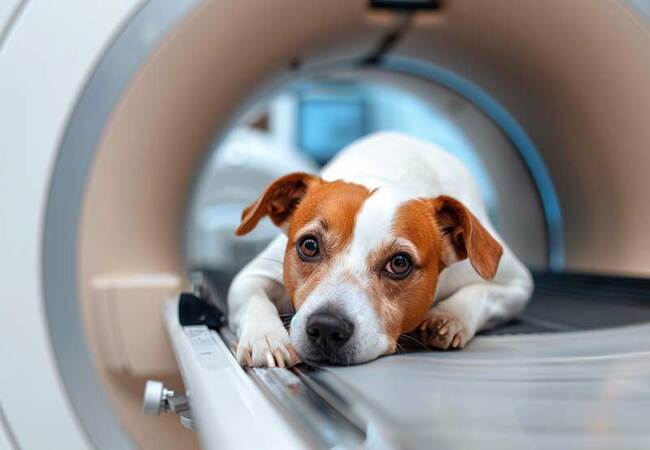Dog MRI 2025: Premium Veterinary Guide 🩺🐾

In this article
Dog MRI 2025: Premium Veterinary Guide 🩺🐾
By Dr. Duncan Houston BVSc
Hello! I’m Dr Duncan Houston BVSc, veterinarian and founder of Ask A Vet. Magnetic Resonance Imaging (MRI) is one of the most advanced, non-invasive diagnostic tools available to veterinarians. In 2025, MRIs provide unmatched clarity for soft tissue, brain, spinal cord, and joint assessments—far surpassing X-rays and CT scans when detailed internal images are essential. 🧠✨
This comprehensive guide dives into when you might need an MRI for your dog, how to prepare, what to expect during and after the scan, insurance and cost considerations, common risks, and how Ask A Vet can support a smooth experience. Let’s help your pet get accurately diagnosed and cared for with confidence!
🧠 1. What Is a Dog MRI?
An MRI uses powerful magnetic fields and radio waves to create detailed cross-sectional images of internal structures, particularly soft tissues like the brain, spinal cord, muscles, ligaments, and organs. Unlike CT or X-ray, MRI distinguishes subtle tissue differences, revealing small lesions, tumors, inflammation, or nerve damage that other modalities may miss.
🔎 2. Why Is an MRI Recommended?
Veterinarians suggest MRI when diagnosing conditions such as:
- Neurological signs—seizures, weakness, gait issues, paralysis
- Brain or spinal masses (tumors, abscesses, herniations)
- Intervertebral disc disease or spinal stenosis
- Complex musculoskeletal injuries not clear on X-ray or CT
- Soft tissue tumors for staging or surgical planning
If standard diagnostics haven’t provided answers, an MRI often delivers the clarity needed for an accurate diagnosis and targeted treatment.
🛠️ 3. MRI versus Other Imaging Tools
| Tool | Best For | Limitations |
|---|---|---|
| X‑ray | Bone fractures, joint alignment | Poor soft tissue detail |
| CT scan | Bone, air-filled structures, fast trauma scan | Moderate soft tissue clarity; uses radiation |
| Ultrasound | Heart, organs, fluid evaluation | Cannot see bone or spinal cord details |
| MRI | Soft tissues, CNS, ligaments, small masses | Costly; requires anesthesia |
MRIs are often the best choice when soft tissue detail is crucial.
📝 4. Preparing for the MRI
- Medical history & consultation: Vet review of health history, medications
- Fasting: No food (water usually allowed) from the night before
- Pre-MRI tests: Blood work and chest X-ray to confirm anesthesia safety
- Comfort aids: Possible premed sedation (e.g. gabapentin/trazodone)
- IV catheter: Established before anesthesia and/or contrast injection
🏥 5. The MRI Procedure Explained
- Anesthesia or Sedation: Complete stillness is essential during imaging. Dogs undergo general anesthesia with full monitoring (ECG, BP, oxygen)
- Positioning: The dog is positioned with supports for comfort and optimal imaging
- Scanning: Lasts 30–90 minutes depending on body area; loud, clanging noises are normal under anesthesia
- Contrast dye: Gadolinium may be administered IV to highlight abnormalities
- Image processing: A radiologist or neurologist reviews and interprets scans; results take 1–3 days
⚠️ 6. Risks & Safety
- Anesthesia: Major risk factor; older or frail dogs require tailored protocols
- Magnetic safety: No metal objects or pacemakers during the scan
- Impatient revival: Dogs may feel groggy or disoriented post-anesthesia for 12–36 hours—monitor home environment carefully
- Contrast reactions: Very rare, but monitored during injection
💵 7. Cost Overview
Dog MRI typically costs $2,300–$5,000+, depending on facility type, complexity, and region.
- Vet clinic (low-field MRI): $2,500–3,500
- Specialty/referral hospital (high-field MRI): $3,000–6,000
- Standalone imaging centers: $2,500–5,000
- Teaching hospitals: $2,500–4,000
Variations due to region, equipment, anesthesia duration, and pre- and post-care services.
Insurance (pet, CarePlus, CareCredit) may help offset costs—check coverage carefully.
🏡 8. Aftercare & Recovery
- Immediate post-op: 30–60 min monitored reviving; some sedation grogginess up to 12–36 hrs
- Home care: Offer water, light food; supervise during recovery; avoid hazards
- Monitor: Watch for vomiting, weakness, breathing changes; call vet if concerns arise
- Follow-up: Results discussion in 1–3 days; further treatment planning
📈 9. How MRI Influences Treatment
- Precision diagnosis: Identifies exact lesion location and nature for targeted interventions
- Surgical planning: Maps out precise surgical margins or tumor removal limits
- Neurological care: Guides therapy for intervertebral disc disease, tumors, and encephalitis.
- Monitoring progression: Tracks changes in chronic conditions or treatment response over time
🧠 10. Ask A Vet Enhancements
- Ask A Vet: Tele‑consults before scanning for risk assessment, aftercare support, and help to interpret results
🔚 11. Final Thoughts
In 2025, MRI for dogs represents a cutting-edge diagnostic tool—non-invasive, highly accurate, and invaluable for diagnosing central nervous system, soft tissue, and musculoskeletal conditions. While it involves anesthesia and cost, the insights it provides can dramatically improve treatment outcomes. With careful planning, compassionate aftercare, and support via Ask A Vet, owners can confidently navigate the MRI journey and secure the best possible care for their pets. If your veterinarian suggests an MRI, understanding the process fully ensures you're prepared for a safe and successful diagnostic experience.






